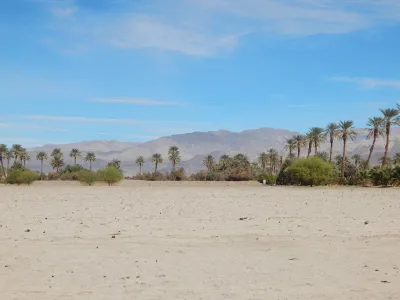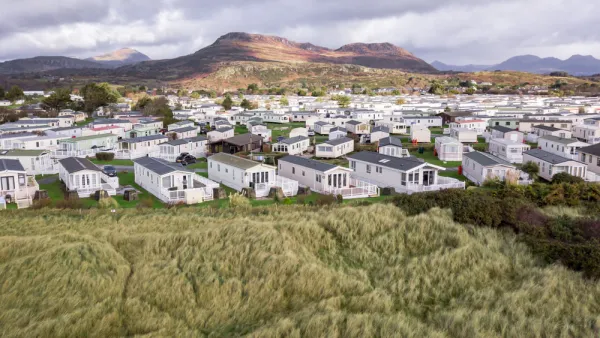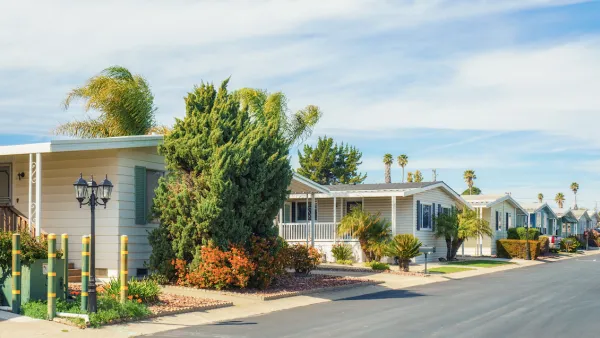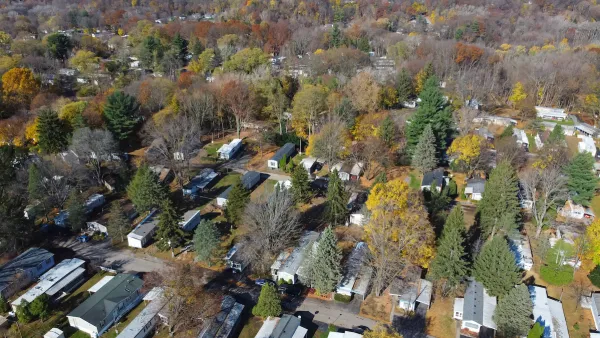In the low desert of Southern California, dwindling water supplies and a lack of infrastructure funding pose major challenges for working-class communities struggling to survive.

Just east of the lush golf courses and sparkling pools of Palm Springs, another world reveals the toll that Southern California's thirst for water has taken on the region's desert communities. Elizabeth Weil and Mauricio Rodríguez Pons describe the "climate gap" that separates the eastern and western sides of the Coachella Valley, and its impact on local residents.
"[T]he east side, the Thermal side, is a gray-green checkerboard of fallow and irrigated fields of grapes, bell peppers and golf-course turf, plus stands of date palms. Interspersed are sun-bleached trailers, homes for the people who work those fields and clean the pools and hotel rooms farther west," as well as several high-end resorts. Plans are in place to build even more extravagant resorts, like the "Thermal Beach Club, which will feature an artificial 20-acre surf lagoon with custom waves, created by PerfectSwell wave technology." But the trickle-down mentality that has sustained the region seems to be wavering as reality for many working-class residents of the Valley fails to live up to the hope that "[w]ealthy tourists, retirees and vacation-home owners will bring in jobs and tax revenue, and, like the sprinklers at resorts, green the whole place up."
With most Thermal residents living in mobile home parks, the issue of how these buildings will fare as climate change leads to more extreme weather is an important, if understudied, one. "In California, mobile homes are disproportionately located in the hottest census tracts. Due to a lack of 'walling integrity' — i.e., holes and lack of insulation — people living in such housing spend twice as much of their income on cooling." Residents also become exposed to arsenic as wells dry up, leading to increased risk of cancer and other diseases.
The article goes on to describe the vast gap between the workers who keep the Coachella Valley humming and the extravagant clubs and resorts dotting the area, and the hardships faced by residents who are finding it harder to access affordable, safe housing. "In the past eight years, Riverside County has only issued permits for 4.2% of the low-income housing that the state of California determined it needed to build, and for 4.9% of the very-low-income housing," which would serve the farmworkers who, "who, on average, earn between $15,000 and $17,499 a year." And despite a plan from the Coachella Valley Water District to connect rural areas to safe water supplies, "the district doesn’t have the money to execute even that limited plan."
Facing a severe lack of institutional support, local policymakers are still looking to private development as a path to getting badly needed infrastructure funding. Speaking to representatives of the Thermal Beach Club, Riverside County Supervisor Kevin Jeffries said, "I’ll take you in a heartbeat to help get some streets paved, some water lines in, some sewer lines in, because we don’t have them in parts of the community ... and there’s none in sight."
FULL STORY: Postcard From Thermal: Surviving the Climate Gap in Eastern Coachella Valley

National Parks Layoffs Will Cause Communities to Lose Billions
Thousands of essential park workers were laid off this week, just before the busy spring break season.

Retro-silient?: America’s First “Eco-burb,” The Woodlands Turns 50
A master-planned community north of Houston offers lessons on green infrastructure and resilient design, but falls short of its founder’s lofty affordability and walkability goals.

Delivering for America Plan Will Downgrade Mail Service in at Least 49.5 Percent of Zip Codes
Republican and Democrat lawmakers criticize the plan for its disproportionate negative impact on rural communities.

Test News Post 1
This is a summary

Test News Headline 46
Test for the image on the front page.

Balancing Bombs and Butterflies: How the National Guard Protects a Rare Species
The National Guard at Fort Indiantown Gap uses GIS technology and land management strategies to balance military training with conservation efforts, ensuring the survival of the rare eastern regal fritillary butterfly.
Urban Design for Planners 1: Software Tools
This six-course series explores essential urban design concepts using open source software and equips planners with the tools they need to participate fully in the urban design process.
Planning for Universal Design
Learn the tools for implementing Universal Design in planning regulations.
EMC Planning Group, Inc.
Planetizen
Planetizen
Mpact (formerly Rail~Volution)
Great Falls Development Authority, Inc.
HUDs Office of Policy Development and Research
NYU Wagner Graduate School of Public Service





























